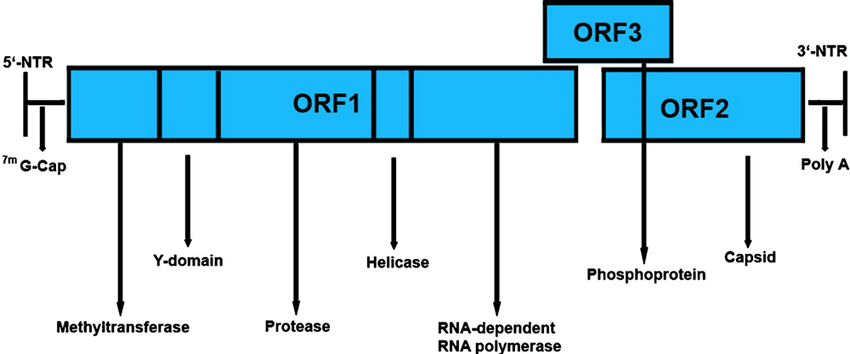Virus–host recombinant variants (VHRVs) were described in immunocompromised patients infected with genotype 3 HEV strains. These variants have the insertion of human gene fragments in the polyproline rich region (PPR): they are part of ribosomal protein genes, such as S17 (1) or S19 (2), tyrosine aminotransferase, or inter-alpha-trypsin inhibitor (3) or nucleoprotein Ahnak, Glutathione S-transferase A1 and ribosomal protein L18 (4). To date, the replicative capacity of only 3 strains were studied in cell culture systems (S17, S19 and TAT) and all presented an in vitro replicative advantage in comparison with the strain without human gene. The one harboring S17, named Kernow P6, was used for most studies.
Previously, Lhomme et al. identified 7 new VHRVs with human gene fragments derived from the genes encoding ring finger protein 19A (RNF19A), zinc finger protein 787 (ZNF787), kinesin family member 1B (KIF1B), eukaryotic translation factor 1 alpha 1 (EEF1A1), 18S ribosomal pseudogene 5 (RNA18), and ribosomal proteins S17 (RPS17) or L6 (RPL6) (5). The replicative capacity of these strains remains unknown even though one might speculate that such human fragments could confer a replicative advantage, at least in vitro.
In a recent study led by Dr. Sébastien Lhomme from Université Toulouse III-Paul Sabatier, France (6), the authors used the Kernow P6 backbone to substitute the S17 fragment by the 7 fragments described previously. They measured the HEV RNA concentration in the supernatant and the cell lysate, until day 14. They also determined the number of foci on day 5 post infection. Laslty, they measured the concentration of the ORF2 protein in the supernatant. Taken together, the results showed that 5 of the 7 VHRVs presented a replicative advantage in vitro based on the HEV antigen and RNA concentration in supernatant and cell lysates and on the number of foci. Only the VHRVs with human gene fragments derived from RPL6 and RNA18 did not show any replicative advantage. In an attempt to understand the mechanisms leading to such replicative advantage, the authors used in silico tools allowing the prediction of post-translational modifications (PTMs), including, acetylation, ubiquitination or methylation. It is known that such PTMs could modify protein activity. Prediction of nuclear localization signal was also performed. However, none of these predictions could be associated to a specific in vitro phenotype. Further investigations are still needed to understand the mechanisms conferring this replicative advantage.
Read the recent study published in The Journal of Virology (May 2024; online ahead of print): DOI: 10.1128/jvi.00295-24
References
- Shukla P, Nguyen HT, Torian U, Engle RE, Faulk K, Dalton HR, Bendall RP, Keane FE, Purcell RH, Emerson SU. 2011. Cross-species infections of cultured cells by hepatitis E virus and discovery of an infectious virus-host recombinant. Proc Natl Acad Sci U S A 108:2438-2443.
- Nguyen HT, Torian U, Faulk K, Mather K, Engle RE, Thompson E, Bonkovsky HL, Emerson SU. 2012. A naturally occurring human/hepatitis E recombinant virus predominates in serum but not in faeces of a chronic hepatitis E patient and has a growth advantage in cell culture. J Gen Virol 93:526-530.
- Lhomme S, Abravanel F, Dubois M, Sandres-Saune K, Mansuy JM, Rostaing L, Kamar N, Izopet J. 2014. Characterization of the polyproline region of the hepatitis E virus in immunocompromised patients. J Virol 88:12017-12025.
- Biedermann P, Klink P, Nocke MK, Papp CP, Harms D, Kebelmann M, Thurmer A, Choi M, Altmann B, Todt D, Hofmann J, Bock CT. 2023. Insertions and deletions in the hypervariable region of the hepatitis E virus genome in individuals with acute and chronic infection. Liver Int 43:794-804.
- Lhomme S, Nicot F, Jeanne N, Dimeglio C, Roulet A, Lefebvre C, Carcenac R, Manno M, Dubois M, Peron JM, Alric L, Kamar N, Abravanel F, Izopet J. 2020. Insertions and Duplications in the Polyproline Region of the Hepatitis E Virus. Front Microbiol 11:1.
- Paronetto O, Allioux C, Dimeglio C, Lobjois L, Jeanne N, Ranger N, Boineau J, Pucelle M, Demmou S, Abravanel F, Chapuy-Regaud S, Izopet J, Lhomme S. 2024. Characterization of virus‒host recombinant variants of the hepatitis E virus. J Virol doi:10.1128/jvi.00295-24:e0029524.

